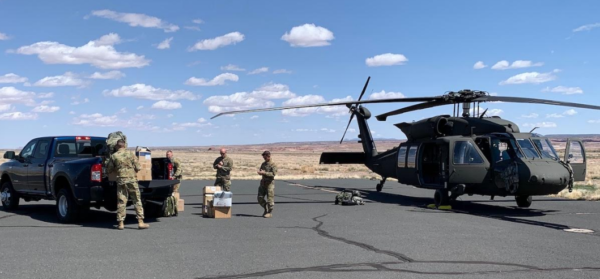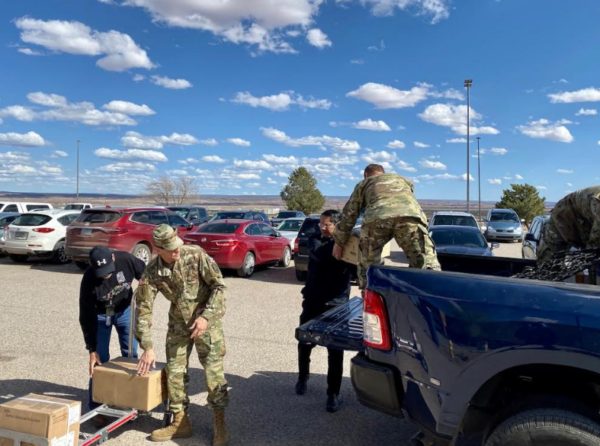
- Details
- By Native News Online Staff
WINDOW ROCK, Ariz. — With the expected peak of the coronavirus still ahead for the Navajo Nation, the Arizona National Guard on Saturday delivered some Personal Protective Equipment (PPE) in Chinle, Ariz., one of the hotspots on the largest Indian reservation in the country.
The PPE will be sorted and distributed to surrounding medical facilities for health care workers to use in the fight against the spread of COVID-19. The items were donated from various businesses in the Phoenix area.
“We don't have the best health care on the Navajo Nation, but we are stepping up to get as much equipment as possible to help those on the frontlines,” Navajo Nation President Nez said. “As the first people of this country, we should not be the last to get equipment. We thank all of the businesses who contributed to help our health care workers.
"We just have to constantly remind our federal and state partners that we are still here! We are resilient just like our ancestors and we will continue to prosper long after this pandemic is over.”
The Navajo Nation leaders also met with the Chinle Comprehensive Healthcare Facility Incident Command team to discuss strategies to mitigate the surge in new COVID-19 cases and to increase staffing for the federal medical station.
 Navajo Nation President Jonathan Nez and Vice President Myron Lizer assist the Arizona Army National Guard with delivering supplies in Chinle, Ariz. on April 4, 2020.
Navajo Nation President Jonathan Nez and Vice President Myron Lizer assist the Arizona Army National Guard with delivering supplies in Chinle, Ariz. on April 4, 2020.
The U.S. Army Corps of Engineers will complete a rapid risk assessment on potential sites in the coming days in Chinle and Kayenta, then provide recommendations on which facility best meet the needs and standards, according to the healthcare guidelines and health experts.
The establishment of these medical stations will likely shelter patients who test positive for COVID-19 from those who show less severe symptoms, to isolate the virus and prevent it from spreading.
More supplies will continue to be delivered by the National Guard, as first responders continue to fight COVID-19 on the frontlines.
A Public Health Emergency “Stay at Home Order” remains in effect on the Navajo Nation requiring all residents of the Navajo Nation to stay home and isolate 24 hours a day, seven days a week, except for essential work and activities.
The Navajo Nation’s daily curfew also remains in effect from 8:00 p.m. to 5:00 a.m. The curfew does not apply to essential employees reporting to or from duty, with official identification and/or a letter of designation from their essential business employer on official letterhead which includes a contact for verification.
More Stories Like This
Native News Weekly (August 25, 2024): D.C. BriefsUS Presidents in Their Own Words Concerning American Indians
Native News Weekly (December 14, 2025): D.C. Briefs
Wounded Knee Massacre Site Protection Bill Passes Congress
Two Murdered on Colville Indian Reservation
Help us defend tribal sovereignty.
At Native News Online, our mission is rooted in telling the stories that strengthen sovereignty and uplift Indigenous voices — not just at year’s end, but every single day.
Because of your generosity last year, we were able to keep our reporters on the ground in tribal communities, at national gatherings and in the halls of Congress — covering the issues that matter most to Indian Country: sovereignty, culture, education, health and economic opportunity.
That support sustained us through a tough year in 2025. Now, as we look to the year ahead, we need your help right now to ensure warrior journalism remains strong — reporting that defends tribal sovereignty, amplifies Native truth, and holds power accountable.
 The stakes couldn't be higher. Your support keeps Native voices heard, Native stories told and Native sovereignty defended.
The stakes couldn't be higher. Your support keeps Native voices heard, Native stories told and Native sovereignty defended.
Stand with Warrior Journalism today.
Levi Rickert (Potawatomi), Editor & Publisher

